How to take the necessary measurements?
To find out the optimal size of curtains for a window, you will need the following things:
- a measuring tool – a school ruler or a sewing tape measure will do, but it is advisable to use a construction tape measure of at least 5 meters;
- a pencil and a notebook.
Before determining the exact dimensions, you first need to find out the length of the cornice, which is usually wider than the window. The distance from the opening to the end of the crossbar on the sides is approximately 15-40 cm. It all depends on the density and width of the curtains. The length of the rod is measured to the stoppers, since the curtains will not go beyond them anyway. If there are no such limiters and the canvas moves freely, then the full length of the crossbar will be needed. You also need to calculate the dimensions from the cornice to the floor covering and to the upper edge of the window sill. And only after calculating these parameters, you can calculate the length and width of the curtains.
Advice. Do not write down the obtained values on a piece of paper, it is easy to lose, enter the data directly into a notebook or workbook.
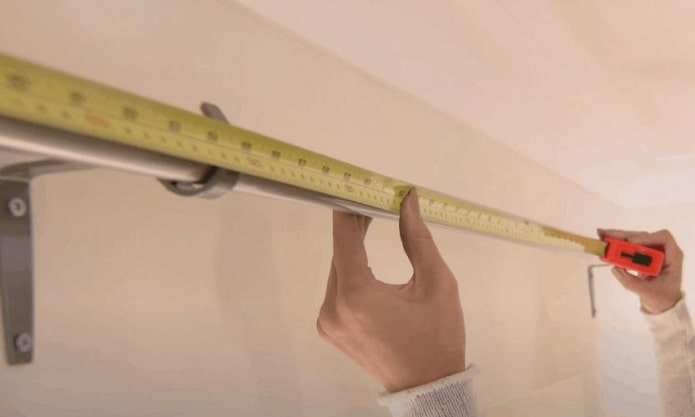
Size recommendations for different types of curtains
The sizes of Roman blinds are calculated based on the dimensions of the window. When raised, such a fabric forms neat folds, the standard size of which is 20 cm. When calculating their number, the height of the window is taken into account. To this parameter, add 10 cm for indents at the bottom and top. You also need to add about 2-3 cm on the sides of the fabric so that the curtain completely covers the window without gaps.
Roller blinds are fixed to the window sash or opening. When fixing the fabric using the first method, first measure the distance from one glazing bead to the opposite horizontally and vertically. In addition, you need to find out the width of the sash frame. In this case, the curtain controls should be easy to move.
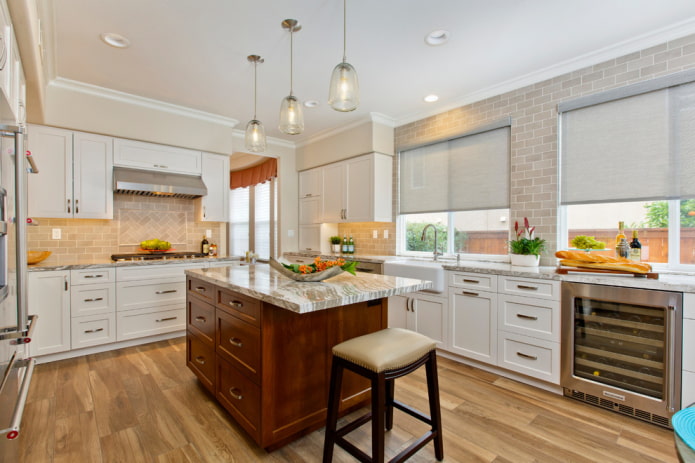
If you plan to fix roller blinds to a window opening, first measure the width of the window. Add at least 6 cm on the sides to this parameter. Thanks to the additional volume, there will be no gaps between the curtain and the window, and bright light will not penetrate into the room. Then calculate the length of the opening. For allowances at the top and bottom of the fabric, add 7 cm on each side.
Japanese curtains, which are pieces of fabric, are usually installed on a ceiling cornice. One panel is approximately 60-80 cm wide. To determine their dimensions, perform the following calculations:
- Divide the length of the rod by the dimensions of the fabric pieces. This gives the required number of panels.
- Using a tape measure, measure the distance from the cornice to the floor. As a result, the approximate height of the curtains becomes clear. Another 1-1.5 cm is subtracted from the result, since the panels should not touch the floor.
What are the nuances for different rooms?
Typical dimensions – the width of the curtains is twice the window opening, and the length of the fabric to the floor. However, this technique is not suitable for all rooms.
The kitchen is a room with high humidity. When cooking, splashes of water and grease fly in all directions, including on the curtains. Therefore, in such a room, you should not hang long and thick curtains made of expensive fabric.
It is better to opt for short panels up to the windowsill without a lot of deep folds. A lot of dust, dirt and grease accumulate in the folds of the fabric. The assembly coefficient should not exceed 1.5.
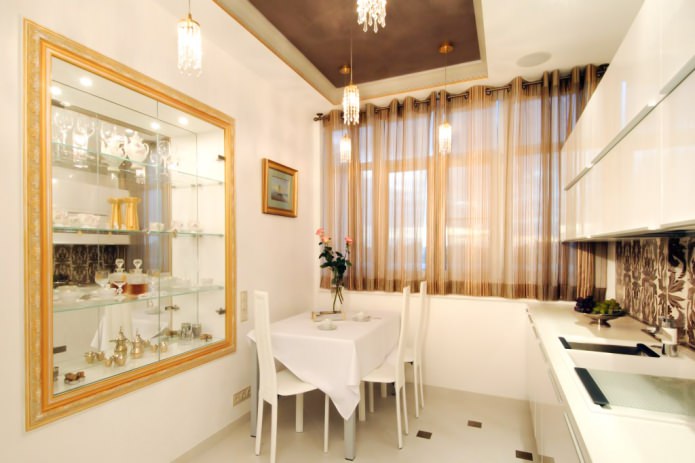
Roman and roller blinds are suitable for the kitchen, the dimensions of which correspond to the window opening or glass. In general, when choosing the length of the curtains, you need to consider the location of the window. Shortened curtains are a good option if the opening is next to the stove. When the window is located far from the cooking area, you can hang a long canvas, but not touching the floor.
When choosing curtains for the living room, it is important not to make a mistake with the length. The first thing that catches the eye of guests is a properly decorated window. Curtains should match the interior. The classic decor option is perfect for the living room:
- curtains, the bottom edge of which does not reach the floor by about 1-1.2 cm;
- curtains with an average number of folds, so that the sun’s rays can freely illuminate the room.
Curtains in the living room can be straight, with fringe, grabs or lambrequins, they are combined with thread curtains, organza or tulle.
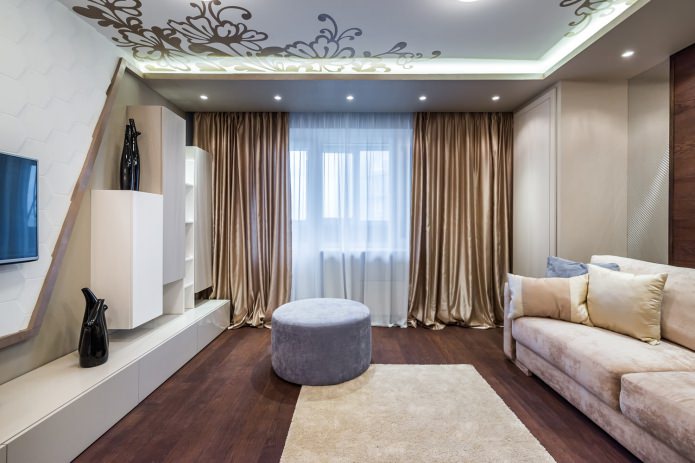
The bedroom is usually decorated with thick floor-length fabrics to make the environment more private. In addition, such fabrics prevent sunlight from penetrating in the morning. Long curtains touching the floor with voluminous folds at the bottom are popular in bedrooms. To achieve this effect, at least 20-40 cm are added to the original size of the curtains.
It is always recommended to decorate a window in a bedroom with low ceilings with floor-length curtains. This technique will help to visually increase the height of the walls. To enhance the effect, preference should be given to fabrics of cold and pastel colors – they will visually expand the room.
When the window in the bedroom is above the bed, it is better to use short curtains to the windowsill. Blackout roller blinds will be an excellent choice for this room. Bright light will not penetrate into the bedroom through the dense fabric.
Children’s rooms, as a rule, have a small area. The child will have to refuse massive curtains in the bedroom. The baby will be uncomfortable in a dark room with thick curtains to the floor. It is advisable to decorate the window in the nursery with a light fabric of medium density. The length to the windowsill is quite enough, in long curtains children can get tangled and tear them off along with the tulle.
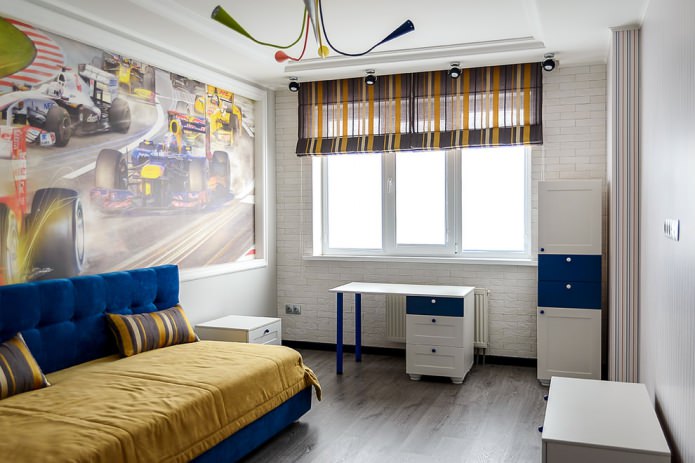
In a teenager’s room, it is acceptable to hang curtains that do not reach the floor by 1 cm. If there is a desk by the window, it is appropriate to use a curtain rod that is slightly shorter than the window sill, or Roman blinds. The recommended width of a curtain in a nursery is 1.5-2 times the length of the cornice. The folds should not be too voluminous. Eyelets or loops are suitable for fastening curtains. With them, the child will be able to easily move the canvases apart.
How to calculate the length of curtains?
Curtain fabrics, jacquard, tapestry and velvet, are produced in rolls, the width of which can be 140, 280 and 300 cm. It is necessary to choose thick curtains. Their lower edge should not reach the floor by 10-15 cm. You need to buy fabric with a reserve, extra centimeters are used for hemming the fabric.
Organza, veil and tulle are sold with a width of about 2.8 m. The length of light fabrics should fit into this parameter, taking into account processing and hems. Calculating the required amount of material will not be difficult.
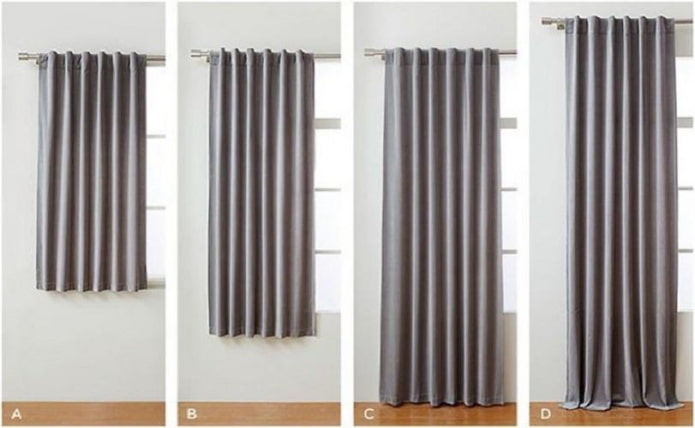
To know the exact length, you need to understand the type of curtains. They are:
- Elongated. The curtains lie on the floor. Their size corresponds to the distance from the rod to the covering plus 10-30 cm.
- Standard. The size of such canvases almost reaches the floor. A gap of 1-2 cm is left on purpose, since the curtains can stretch slightly under their own weight.
- Medium. The bottom of the curtains in this case is located below the window sill by about 10-15 cm.
- Short. The size of these panels is equal to the distance from the cornice to the top of the window sill. When calculating the length, another 1 cm is subtracted so that the products can be moved apart freely. Short fabrics are used mainly in the kitchen.
When determining the length of the curtains, the fastening system is also taken into account: eyelets, fabric loops, curtain tape, hooks and others. For example, if the curtains hang on loops, their height is determined from the beginning of the fastening. When the fabric is fixed on hooks using curtain tape, the length is measured from the bottom of the holder. When using eyelets, the height of the panel is calculated from the extreme edge of the cornice, 2 cm are added to the result obtained for the rings.
Additional information. When calculating the length, do not forget about allowances. It is worth buying curtains with a reserve for hemming the edges. Otherwise, the fabric may fluff up over time.
How to calculate the width of curtains?
This parameter is important, since the wrong length can be played up. Too narrow curtains cannot be hidden. Gaps between the canvas and the window will spoil the design of the room.
The width of the curtains is easy to calculate. You will need the following parameters:
- assembly coefficient (AC);
- length of the curtain rod.
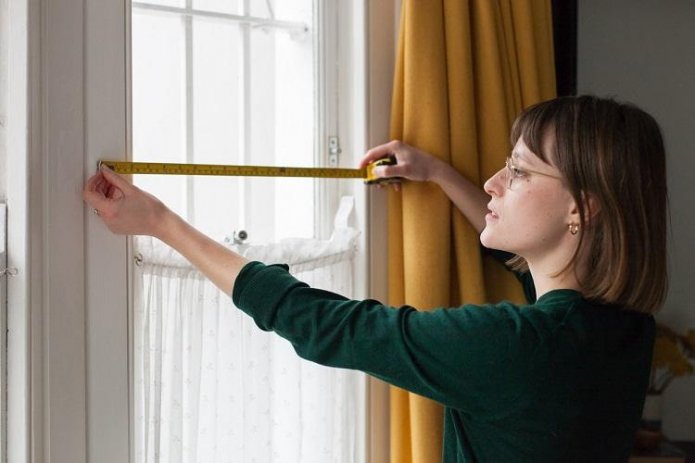
Curtains look more attractive when they have drapery. When calculating the width of the fabric, you need to take into account the number of folds. Their number depends on the type of fabric:
- Light fabrics, including plain veils, organza or tulle, allow AC = 4. In other words, the width of translucent fabrics should be 2-4 times greater than the length of the rod. If the curtains have a print, the assembly coefficient is no more than 2.
- Satin and other medium-density materials require KS=2.5.
- Velvet and other dense products require KS=2.
The formula for calculating the width of the canvas is as follows: the length of the cornice is multiplied by KS. When calculating the number of folds on the curtains, the following is also taken into account:
- Interior design. In the Provence or classic style, many folds are made on the textile product. Smooth canvases without splendor are suitable for high-tech and minimalism.
- Patterns on fabric. If the curtains have large patterns, it is better to use a minimum of waves.
- Room dimensions. The larger it is, the more voluminous the curtains are chosen.
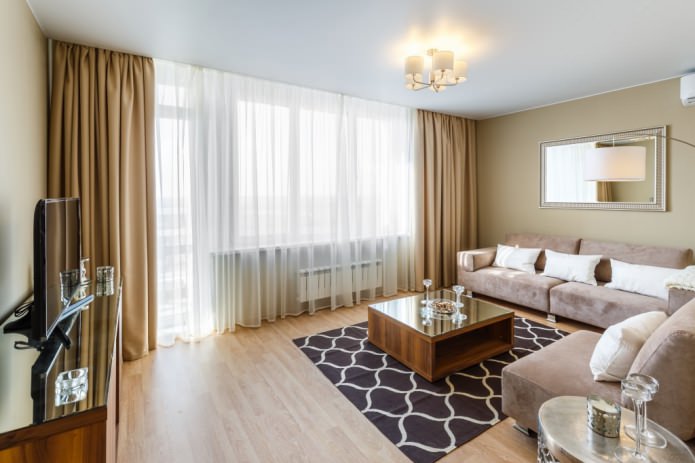
The width of the curtain fabric is calculated as follows: the size of the rod is multiplied by the gathering coefficient and divided by the number of curtains. Finished products are most often sold with the edges processed on the sides. If the fabric is not hemmed, then you need to add 5 cm on each side.
When the width of the roll is small, several curtains are sewn together. The number of panels for connecting the curtains depends on the print on the textile and the fluffiness coefficient. To sew them, you will need additional centimeters to connect the pattern. Of course, this is financially unprofitable.
Calculation examples
The procedure for finding out the width of one curtain: divide the size of the curtain rod by the number of panels, then multiply by the coefficient of KS and add a few centimeters for overlap. Let’s look at an example: two curtains, a rod 4 m long, assembly coefficient – 2.5.
The formula looks like this: (4:2) × 2.5 + 0.05 = 5.05 m – the width of the finished product. If you plan to sew the curtains yourself, then add another 2.5 cm for processing the fabric on the sides. This means that you need to add 0.05 m to 5.05 m. As a result, you will need 5.10 m of fabric, not hemmed at the edges.
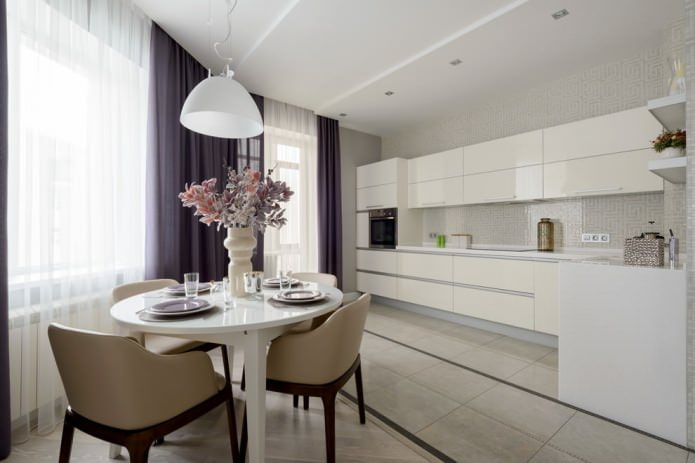
The fabric consumption by height can be found out using this formula: the total length of the fabric plus the lower and upper hem. Example: 3 + 0.3 + 0.2 = 3.5 meters.
If the curtains have large patterns, then the number of purchased meters is increased by the height of the repeating pattern. For example, the total length of two curtains is 4 m, and the print size is 50 cm, which means you will need 5 meters of fabric.
It is advisable to buy curtains with a large pattern with a reserve of at least a meter. If you don’t need extra fabric, you can use the leftovers to make cushions. It’s worse when the curtains are too short, you’ll have to lower the rod or create wide stripes, sew on frills to hide the calculation error.
The size of the curtains should be given the same importance as the color, patterns, and fabric. Decorating a window won’t take much time, attractive curtains will make the room more cozy and attractive. Therefore, it is important to know how to calculate the length and width of the curtains yourself.
Now reading:
- Choosing a Sofa Color: Practical Recommendations and Examples for the Interior
- The best carpet for home: advantages and disadvantages, 33 interior photos
- Chester sofa: 35 photos in the interior, options for materials and colors
- Ceiling design: more than 90 photos and ideas for styles and spaces.
- Tips for Updating Your Kitchen on a Budget Without Renovating